The History Of Nissan Gloria Wagon

The Gloria (Japanese: 日産・グロリア) is a large car made from 1959 by the Prince Motor Company, and later by Nissan Motors since its merger with the former - hence being originally marketed as Prince Gloria and later as Nissan Gloria. Initially based on the smaller Prince Skyline, the Gloria line was merged with Nissan Cedric starting with 1971 models and both continued until 2004, when they were both replaced by Nissan Fuga.
A V8 engine was never installed in a Nissan Gloria sold in Japan, in the 46 years the vehicle was built.
Glorias were sold at dealerships that were affiliated with the Prince company; when Nissan assumed operations, Glorias were sold at dealerships that sold the Nissan Skyline.
According to the article found in Japanese Wikipedia, the Gloria got its name as a tribute when the first series BSLI sedan was presented to the then Crown Prince Akihito, the future Emperor of Japan, and Princess Michiko as a anniversary gift after one year of marriage. The Prince Automotive Industry was the official vehicle supplier to the Imperial Household at that time, previously known as Fuji Precision Technology. It was inspired by the Latin word "Glory".
The Prince Automobile Manufacturers, previously known as Fuji Precision Industry, released a modification of their Prince Skyline with a more luxurious approach, and modified exterior sheet metal, at the All Japan Automobile Show, after the Tokyo Motor Show and the Skyline 1900 exhibition, on October 1958. February 1959 the Gloria was released with the 1.9 L OHV 4 cylinder engine.
In April 1959, the Crown Prince and future Emperor of Japan was presented with the first Gloria.
For 1961 and 1962, Prince modified the Skyline with a larger 1.9 L engine and more luxury features. The GB-30 straight-4 produced 80hp (60kW).
The suspension used double wishbone and coil springs in the front, and De Dion setup in the back.
Later that same year, Prince introduced the S40 Gloria. It was the first 6-cylinder Prince, offering an updated straight-4, the 94hp (70kW) 1.9L G-2, or a straight-6 variant known as S41 Gloria 6. This new engine, called the G-7, produced 106hp (79kW) with a new SOHC head. The Gloria had an independent suspension in front and a de Dion tube in the back.
A prototype of the Second Generation Gloria had many design similarities to the Chevrolet Corvair, so the car was completely redesigned.
On October 1962 at the 9th All-Japan Auto show, the 2.5 L engine was presented.
On June 1963, the first mass produced SOHC 6 cylinder engine was introduced, known as the G7, and was installed in the Super Gloria 6, model S41D-1. The same engine was used in the Gloria 6 Estate and in a commercial delivery van.
On May 1964, the Grand Gloria S44P was released. This vehicle included electric power windows and a 2.4 L engine. The 2nd Japan Grand Prix T-IV class saw the GR7A Gloria Super 6 engine win the race installed in a Skyline.
On August 1966, the Nissan Motor Company merged with the Prince Motor Company, and the Gloria was known as the Nissan Gloria Prince.
The then current Emperor of Japan was presented with a special version of the Gloria, known as the Nissan Prince Royal.
The S44 Gloria was available with the G11 2500 cc engine.
April 1967 saw a restyle of the bodywork, and all Prince vehicles were now known as Nissan. The former Prince company, now a division, was given the task of designing the Nissan Prince Royal, to be used by the Imperial Household, and presented a special version of the Gloria, which had a similar appearance to the previous Royal Prince. The styling of this generation was said to emulate Pontiacs and Cadillacs during the same time period. Vehicles designated as the Super 6 and Van Deluxe had the 6 cylinder engine, whereas the Standard and Van Standard used the 4 cylinder engine. Later the Super Deluxe GL became the top trim level. Due to the Gloria and Cedric being combined to save on production costs, the De Dion axle previously used by the Prince Gloria was changed to the solid rear axle with leaf springs.
In 1971, the Gloria model was merged with its former competitor, the Nissan Cedric, to become the Nissan Gloria. This name was also used in some export markets instead of the Cedric or 260C moniker. The name continued in use through the latest Cedric model line.
After the S44 was the PA30 sedan and WA30 wagon, which were only available with either the G7 or G11 engines.
Disc brakes for the front wheels were added to the options list.
Starting with this generation on February 1971, the Cedric and Gloria were essentially the same vehicle, with the Gloria being more upscale than the Cedric. The hood ornament is a stylized version of the Japanese Crane. The primary differences are the hood, radiator grille, taillights and wheel covers.
The 4 cylinder is the H20 series OHV engine, with the 6 cylinder engine using the L20 twin carburetor, sourced from manufacturer SU carburetor. The H20P uses LPG for fuel, and the SD20 OHV is a diesel engine. The SD20 was the first time a diesel engine was offered in a Gloria.
October 1971 saw the 2.5 L L26 6 cylinder engine added to the options list.
On August 1972, both a 2 door hardtop coupe and 4 door hardtop was added, to compete with the Toyota Crown coupe.
This generation of the Gloria has been completely shared with the Cedric, essentially being the same vehicle, aside from changes in appearance. Halogen headlights are introduced to the Gloria, along with both a 2 door and 4 door hardtop body style, in addition to a 4 door sedan. Twin carburetors are removed from the L20 4 cylinder, due to emission regulations. The 2.8 L engine is replaced with the 2.6 L and used on the 4 door sedan for taxi usage, and uses LPG fuel.
October 1975 saw the introduction of the 2000GL-E and the 2000SGL-E, with the "E" designation signifying fuel injection.
June 1976 saw cosmetic changes, with halogen headlights being used on all versions except the sedan used for taxi service. Wheel covers are now painted to match the exterior body color.
June 1977 saw the introduction of the 2800 E Brougham at the top of the options list. The SD22 2.2 L diesel on the basic sedan and wagon, which was a first for the Gloria. Column shift is replaced with a floor mounted system on the 4 door hardtop.
November 1978 saw another emissions adjustment. Items found on the 2800 Brougham were introduced on the 2000 SGL-E sedan and hardtop. Radial tires are introduced.
June 1979 saw a completely redesigned Nissan Gloria with assistance with Pininfarina, with a more simple and straightforward appearance over the previous generation, and exchanging the single unit halogen headlights with 4 sealed beam headlight units, achieving a more American appearance, similar to the Buick Century during the same time period. Computer controlled fuel injection was added to more engines offered, with the "E" designation signifying fuel injection. The L20ET was the first usage of a turbo on Japanese production vehicles.
The 2 door hardtop coupe was discontinued and replaced with the luxury sports coupe Nissan Leopard.
Trim levels were expanded, and were designated the Brougham, SGL Extra, SGL, GL and the Jack Nicklaus edition which was very similar to the Brougham, which offered the turbo. Other trim levels were the Turbo S, S Custom, Custom Deluxe, Deluxe, Custom, and the Standard at the bottom. The diesel engine SD22 was offered in 1979 on the sedan GL and DX. The Standard SEdan and Van were discontinued April 1981. October 1979, the 6 cylinder LD28 diesel was added with the automatic transmission selector moved from column shift to a floor mounted system. December 1979 was when the first turbo L20ET was introduced, with a 5 speed manual transmission only.
February 1980 saw the LD28 6 cylinder offered with a 5 speed manual transmission installed with a floor mounted shifter, but leaving the column shift for the 4 speed manual transmission. Later in April of that same year the Turbo Brougham appeared with a 4 speed automatic transmission, floor mounted, to the 4 door hardtop model. A glass moonroof was also offered on the options list.
June 4 1983 saw a mild restyle of the previous generation for all versions of the Gloria. Sedans used for taxi service utilized four round headlights whereas other versions upgraded to European style halogen headlights.
The Straight-6 cylinder, which was used for many years, was upgraded to a all new V6 design, called the VG series engine. This was the first, mass production engine used in Japan, and used fuel injection instead of a carburetor for fuel delivery. The VG20ET was turbocharged, another first for Nissan in Japan. The diesel Straight-6 LD28 was also upgraded to the RD28 Straight-6 engine. The CA engine was built to run on LPG fuel and used for taxi service. The 6 cylinder L20P also ran on LPG. In June 1984 the VG30ET turbo V6 was introduced.
Trim levels offered were the Brougham, SGL, Grand Edition, GL Grand Edition, GL and the Standard. In June 1984 the Brougham VIP appeared as the top level car. The Jack Nicklaus special edition, introduced with the previous edition, was a sales success for the company and continued to be offered as a hardtop only with a turbocharged engine. Electronically modified air suspension appeared in June 1984.
June 1985 saw mild exterior changes, with the biggest change being a variable nozzle for the VG20ET turbocharged engine. The LD28 diesel was replaced with the RD28. A sonic modified suspension system was added to the options list, with an upgrade to MacPherson Struts for the front and a rigid link coil suspension for the rear.
June 1987 saw a special-edition Gloria built for parade usage. The sedan remains with unchanged body appearance and is still in production currently. Private Glorias are now only available in 4-door hardtop guise. Engines available continue to be the newly developed VG series engine, with the VG20DET adding DOHC, another first for Nissan.
The 4 speed automatic transmission is now computer controlled for smoother shifts. The transmission now exclusively uses a floor mounted gearshifter, and a 5-speed manual transmission is still available. The rear suspension was upgraded to multi-link independent setup.Trim levels start with the VIP Brougham, Gran Tourismo, Classic SV, Classic and Super Custom. The Gran Turismo received more sport-oriented styling, adding a youthful appearance, which found new, younger, buyers.
The Gloria competed for buyers with related Nissan vehicles that shared platforms used for the Gloria, specifically, the Nissan Cima, Nissan Leopard and the Nissan Cedric, as well as other sport oriented vehicles, such as the Nissan Cefiro, Nissan Skyline and Nissan Laurel.
The Gloria Y31 can be distinguished from its sibling, the Cedric Y31 by the tailights at the back. Unlike its sibling, the Gloria has not received a new body.
This generation was introduced June 1991, and was offered in hardtop only. A center "B" pillar is added to improve vehicle solidity, and improve crash worthiness, but is obscured behind side window glass and frameless side windows. The VG series engine continues to be offered with the 5 speed computer controlled automatic transmission, wht the 4 speed offered with the RD28 diesel engine. A manual transmission is no longer offered.
Trim levels offered were the Gran Turismo SV, Grand Turismo, and the top level vehicle is called the Gran Turismo ULTIMA. Other trim levels offered were the Brougham VIP type C, Brougham G, Brougham, Classic SV and the Classic.
Popularity of the Nissan Cima is beginning to affect sales of the Gloria, as sales are not as high as in past generations.
The Y33 series Nissan Gloria is given a body restyle and introduced June 1995. Major changes were the introduction of the newly developed VQ series engine, and replacing the VG series, with the VQ30DET turbo utilizing an intercooler and DOHC valvetrain architecture. AWD is introduced only on the RB25DET, including Nissan's ATESA E-TS. The diesel RD28 is now only available with a 4 speed transmission. Due to economic pressure, some of the trim levels are discontinued, leaving the Gran Turismo type X, Gran Turismo Ultima, Gran Turismo SV, Gran Turismo S, Gran Turismo, Brougham VIP, Brougham and the Brougham J.
The 4 door sedan is no longer offered.
June 1999 saw the release of the final version of the Gloria, with design assistance from Porsche. Direct Injection is introduced on all engines with the "DD" designation. The AWD was offered only on vehicles with the RB25DET engine. The top levels 300 ULTIMA-Z and the 300 ULTIMA-ZV were available with the CVT transmission.
January 2000 saw Autech release a 40th anniversary edition of the Gloria.
Production of the Gloria ended after 46 years of production, and was replaced by the Nissan Fuga on October 2004.
From Wikipedia, the free encyclopedia
More About Nissan Gloria Wagon
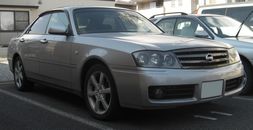
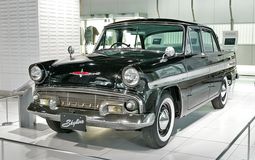
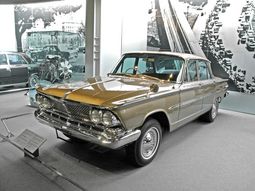
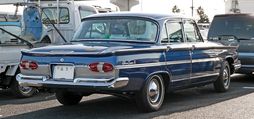
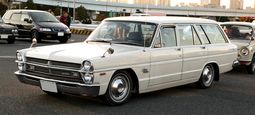
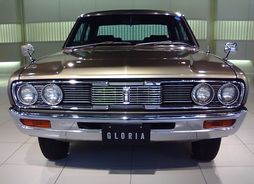


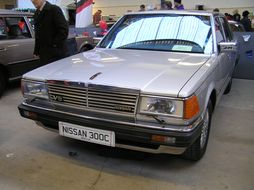


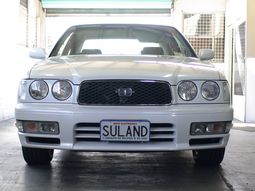
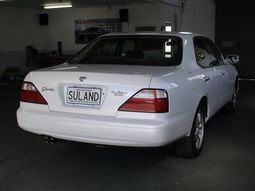

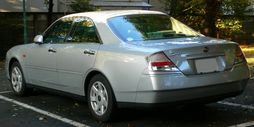
|